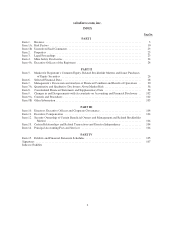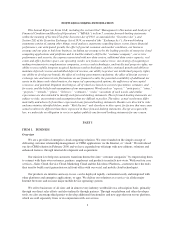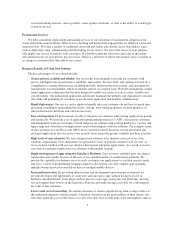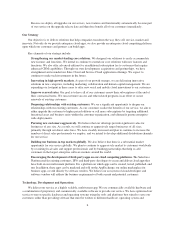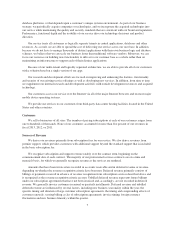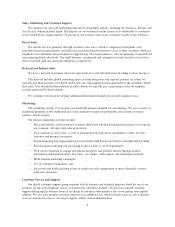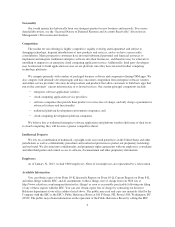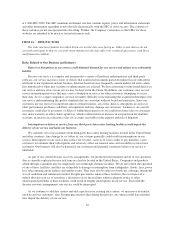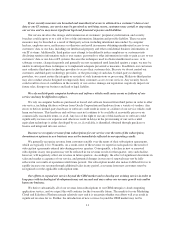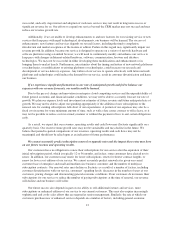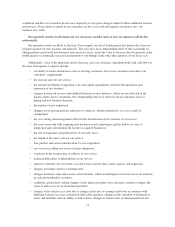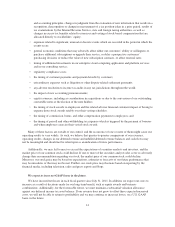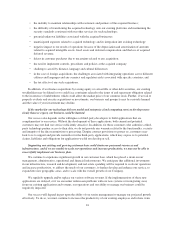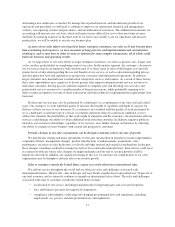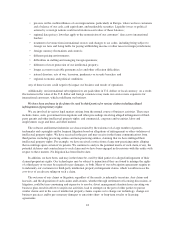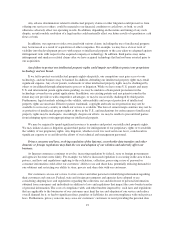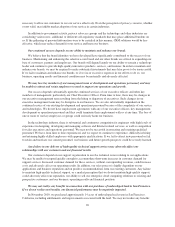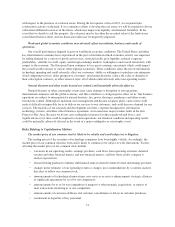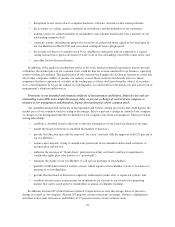Salesforce.com 2013 Annual Report Download - page 16
Download and view the complete annual report
Please find page 16 of the 2013 Salesforce.com annual report below. You can navigate through the pages in the report by either clicking on the pages listed below, or by using the keyword search tool below to find specific information within the annual report.successful, and early stage interest and adoption of such new services may not result in long term success or
significant revenue for us. Our efforts to expand our service beyond the CRM market may not succeed and may
reduce our revenue growth rate.
Additionally, if we are unable to develop enhancements to and new features for our existing service or new
services that keep pace with rapid technological developments, our business will be harmed. The success of
enhancements, new features and services depends on several factors, including the timely completion,
introduction and market acceptance of the feature or edition. Failure in this regard may significantly impair our
revenue growth. In addition, because our service is designed to operate on a variety of network hardware and
software platforms using a standard browser, we will need to continuously modify and enhance our service to
keep pace with changes in Internet-related hardware, software, communication, browser and database
technologies. We may not be successful in either developing these modifications and enhancements or in
bringing them to market timely. Furthermore, uncertainties about the timing and nature of new network platforms
or technologies, or modifications to existing platforms or technologies, could increase our research and
development or service delivery expenses. Any failure of our service to operate effectively with future network
platforms and technologies could reduce the demand for our service, result in customer dissatisfaction and harm
our business.
If we experience significant fluctuations in our rate of anticipated growth and fail to balance our
expenses with our revenue forecasts, our results could be harmed.
Due to the pace of change and innovation in enterprise cloud computing services and the unpredictability of
future general economic and financial market conditions, we may not be able to accurately forecast our rate of
growth. We plan our expense levels and investment on estimates of future revenue and future anticipated rate of
growth. We may not be able to adjust our spending appropriately if the addition of new subscriptions or the
renewal rate for existing subscriptions falls short of our expectations. A portion of our expenses may also be a
fixed cost in nature for some minimum amount of time, such as with a data center contract or office lease, so it
may not be possible to reduce costs in a timely manner or without the payment of fees to exit certain obligations
early.
As a result, we expect that our revenues, operating results and cash flows may fluctuate significantly on a
quarterly basis. Our recent revenue growth rates may not be sustainable and may decline in the future. We
believe that period-to-period comparisons of our revenues, operating results and cash flows may not be
meaningful and should not be relied upon as an indication of future performance.
We cannot accurately predict subscription renewal or upgrade rates and the impact these rates may have
on our future revenue and operating results.
Our customers have no obligation to renew their subscriptions for our service after the expiration of their
initial subscription period, which is typically 12 to 36 months, and in fact, some customers have elected not to
renew. In addition, our customers may renew for fewer subscriptions, renew for shorter contract lengths, or
renew for lower cost editions of our service. We cannot accurately predict renewal rates given our varied
customer base of enterprise and small and medium size business customers and the number of multiyear
subscription contracts. Our renewal rates may decline or fluctuate as a result of a number of factors, including
customer dissatisfaction with our service, customers’ spending levels, decreases in the number of users at our
customers, pricing changes and deteriorating general economic conditions. If our customers do not renew their
subscriptions for our service or reduce the number of paying subscriptions at the time of renewal, our revenue
will decline and our business will suffer.
Our future success also depends in part on our ability to sell additional features and services, more
subscriptions or enhanced editions of our service to our current customers. This may also require increasingly
sophisticated and costly sales efforts that are targeted at senior management. Similarly, the rate at which our
customers purchase new or enhanced services depends on a number of factors, including general economic
12


